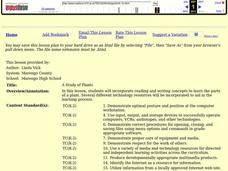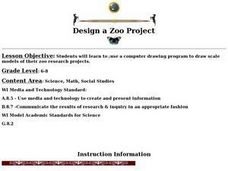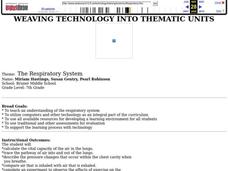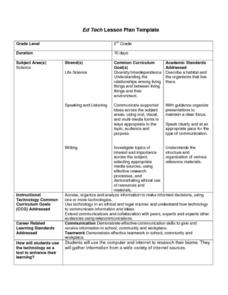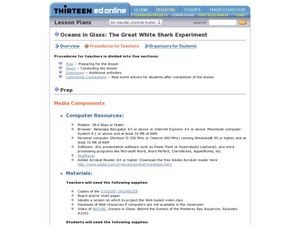Curated OER
A Study of Plants
Using a variety of multi-media resources, your high schoolers become familiar with the parts of plant and create a story about plants using vocabulary learned during their research of plants. Completed stories are published using the...
Curated OER
KORN-TV Newsroom
Role-play to learn. Writers pretend to be a team of news writers. They research information about genetically engineered corn and the impact of biotech food products. Then create a video, Powerpoint, or oral presentation to present their...
Curated OER
From the Mouths of Space Scientists: An Introduction to Space and Weather
After researching the Greenland Space Science Symposium, curious thinkers create a PowerPoint or video presentation. They use the information they gathered to construct their presentation.
Curated OER
Naming New Species
Students explore science of taxonomy and the Five Kingdoms of life,
categorize organisms into Kingdoms, and create multi-media presentations illustrating knowledge of a Kingdom. They collect data and related pictures on the Internet,...
Curated OER
Here Today, Gone Tomorrow
Students explore erosion. Through multi-media and hands-on activities, students identify the effects of wave erosion and hurricanes on a barrier island. Students watch a video and create a cause and effect chart of their observations. ...
Curated OER
Watery World
Students brainstorm to develop resource/reference charts for later use. they are introduced to Microsoft Word and to an internet movie site. They use prepared chart headings, to respond to questions posed on each chart such as: Where do...
Alabama Learning Exchange
A Study of Plants
Pupils study and become familiar with parts of a plant by using multi-media resources. They publish a story about plants using a word processing program and include new plant vocabulary that they have learned.
Curated OER
Design a Zoo Project
Learners research animals to become experts on them. They design a zoo to fit their animal's climate and region. They create a computer drawing of their zoo at the end of the lesson plan.
Curated OER
Exploring Biomes Lesson 2: Biome Research
Learners view a PowerPoint presentation on biomes and their classifications. Divide them into groups and assign them each an individual biome to research. There are pictures of the PowerPoint slides and notes about what to teach for...
Curated OER
Life Cycle of a Salamander
Third graders examine the life cycle of a salamander. In this life cycles lesson, 3rd graders view a PowerPoint presentation about the life cycle of a salamander. Students take the temperature of a toy salamander with a thermometer and...
Curated OER
Flightless Birds and Scientific Research
Students study the work done by various scientists on Antarctica. In this biology lesson plan, students play the role of researchers who must justify the importance of their study. They create a multimedia presentation about a specific...
Curated OER
Designing Experiments - Procedures for Teachers
Learners evaluate a hypothetical experimental design and attempt to improve upon it. In this scientific method lesson, students are presented with an experiment and are instructed to determine its flaws. They conduct their own...
Curated OER
Climate Change
Ninth graders compare the Arctic and Antarctic. In this climate lesson students work in groups, research and complete an oral report or a poster.
Curated OER
Newtonian Mechanics
Students familiarize themselves, through teacher demonstration, with Gavendish's apparatus first used for experimentally determining the value of the Universal Gravitational Constant G, and calculate theoretical value of Earth's...
Curated OER
The Heart of the Matter
Upper elementary pupils learn about the blood transportation system and anatomy of the human heart. They fill in an outline of the human heart (not included) focusing on the flow of blood to and from the heart. Using stethoscopes,...
Curated OER
The Respiratory System
The student will calculate the vital capacity of the air in the lungs and trace the pathway of air into and out of the lungs. They describe the pressure changes that occur within the chest cavity when you breathe. They compare air that...
Curated OER
Thinking Like An Engineer
Students explore physics. They investigate the strategies used by an engineer to solve a problem. Students construct various models to solve the problem. They display their solutions and explain how they solved the problem.
Curated OER
Organisms and Habitats
Second graders investigate biomes and the plants and animals that are native to particular biomes. They participate in a class discussion, conduct Internet research on a selected biome, and create a shoebox biome using their Internet...
Curated OER
Ecosystems Online
Students work together to gather information on ecosystems from websites. They identify plants and animals and create their own website. They are graded on their willingness to work together and the content on the website.
Curated OER
Dig Into Ireland
Students study Ireland and its distinctive culture. In this exploring Ireland lesson plan students view a program on Ireland, answer questions then divide into groups and research the Irish connection.
Curated OER
Oceans in Glass: The Great White Shark Experiment
Students use the Internet to study great white sharks and answer questions. In this ocean lesson students create and produce a website that summarizes the information they obtained in their research.
Curated OER
Backyard Bacteria
Students experiment with different bacterias that they found and make predictions of their growth. In this investigative lesson students use petri dishes to grow their bacteria then summarize what has happened.
Curated OER
Making Blood!
Ninth graders study facts about human blood and what it is made of. In this blood composition lesson students divide into groups and complete several activities.
Curated OER
Taking a Stand: Pros and Cons of Forest Fires
Students explore the pros and cons of forest fires. For this science lesson, students research the ecological implications of forest fires. Students record their findings in journals and compose a persuasive e-mail to government officials.
